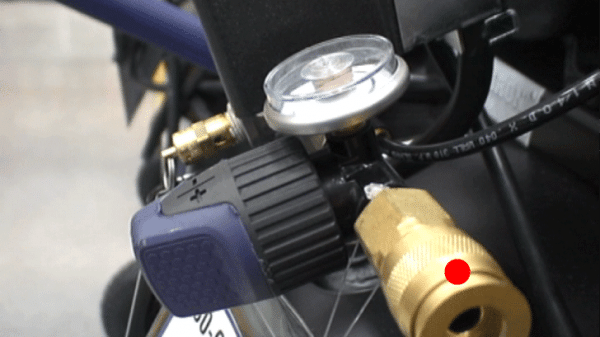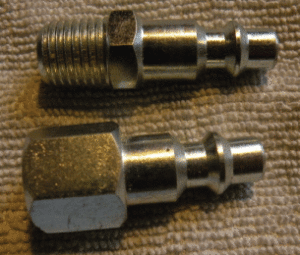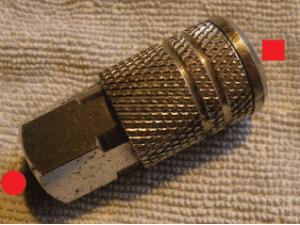It seems simple enough for folks that have had an air compressor for a long time, yet for some, connecting your air tools is fraught with mystery. This page will take all the mystery out of it connecting your air tools for you.
Almost all air compressors come equipped with a discharge coupler. If they didn’t, when you ran the air compressor to build air in the tank, all that air would flow out the end of the air line from the tank. On your air compressor that air path probably flows through the air regulator, and then out the end of the air line to atmosphere. It is the coupler that is installed on the end of that line from the tank that keeps the air in the tank until you need to use it.

The discharge coupler is identified by the red dot in the image above. Yours may look like this one, or perhaps be chromed or galvanized in color.
The discharge coupler on your air compressor is checked. That means that there is a little ball or flap check valve inside that coupler that stops the air from flowing through it, that is, until you plug in the mating connector.
Compressor tank is full
Once the air compressor has run long enough, the tank will be full of compressed air. All of the compressed air in the compressor tank is now yours to be used. How do you get the air from the compressor tank to your air tool, then?
Connecting your air tools
You will need a flexible air line or air hose to carry the compressed air from the compressor to the air tool you wish to use.
On either end of the air hose will be, or should be, air tool connecting devices. If your air hose has only a male thread on one end and a female thread on the other, or male threads on both ends, you will need to add couplers and connectors.
One of the ends of the air hose or air line will have a connector on it. Typical compressed air connectors are shown in the next image.

The right side of these two compressed air connectors are the same. The left side varies a bit. The connector at the top has a male thread on the left side, and the bottom connector has a female thread on the left side.
Quite often your air hose will come equipped with only male threads on the ends, so you will choose the connector with a female thread on it so it will thread onto the male thread on the end of the hose.
On the other end of the hose you will need a checked coupler, one of which is shown in the next image.
Again, typical air connectors are checked, meaning air cannot flow through them unless there is a mating connector plugged in.
Don’t stress about this fact though, as you have to go out of your way to find a compressed air coupler that is unchecked. If you see a coupler and connector kit on your store shelf, it’s a good assumption that the couplers will be of the checked variety.

In the image of the coupler the male thread on your air hose will thread into the end of the connector identified by the round dot.
A connector, one of which is typically threaded into the air supply port on your air tool, would be inserted into the end of the coupler identified by the red square in the image.
A complete air line
By having a connector on one end of your air line and a coupler on the other end, you now have the complete method of getting the air from the discharge coupler on the air compressor to your air tool.
You plug the coupler on the air hose to your air tool connector. You plug the connector on the other end of your air hose into the discharge coupler on the air compressor, that connector opens the check valve inside the compressor coupler, and compressed air flows through the hose from the compressor tank.
Mind you, you have to be sure that the coupler and connector match, as not all makes are compatible. Please see the pages on this site about couplers and connectors for more information about that.
Not quite sure about how things connect on your air compressor or air tools? Post a question here using the comment box below.

Hello, I’ve recently purchased an Einhell TE-AC 270/24/10 air compressor. I want to connect the air hose (female) on both ends, to the compressor. I bought 1/4” BSP, mail screw adaptors. With these in place, I can connect one end of the hose to a tool but cannot connect the other end to the compressor. I have contacted both ToolStation and Einhell directly, but they can’t tell me what adaptor/coupler is needed.
Your help would be very much appreciated.
Thanks and best wishes
Nigel
Nigel, the coupler on the compressor is probably of German make and they are different. Follow this link for information about the differences. That should explain it, I believe.
Can I switch the tools with the air compressor turned off but with the pressure in the tank? My point is: do I have to turn the regulator knob to drop the line pressure to zero every time when I need to switch the tools? The knob tread gets broken relatively soon if I turn the line pressure off/on frequently.
Hello Michael. You shouldn’t have to do so. The coupler into which the air line connector is inserted on the compressor is typically what they call “checked”. This means that when the connector is removed, the coupler closes to air passage until the connector is inserted. This same scenario occurs on typical air line hose couplers, the one into which you plug the connector on the air tool. Remove the air tool connector, there will be a brief burst of air, and then the air flow should stop. If it doesn’t your couplers are either very unusual or there is debris preventing the internal check valve to close when the connector is removed. Hope this helps.
It definitely helps. Thank you, sir, for comprehensive answer.
I mentioned in another question about a new compressor I had just gotten. I had also gotten some air tools on a yard sale. The first tool I don’t think I will use much since it is a circular sander and I don’t I have the CFM capacity.
The second tool is a 3/8″ air ratchet by Campbell Hausfield. My question for this is what maintenance do I have to do on the tool before hooking it up to my compressor? Do I have to put tool oil in it?
Some folks use an in-line oiler for air tools They are usually folks that use them for hours at a time. Me, I just squirt 2-3 drops of air tool oil into the air connector, add the air line, give it a quick burst of air to distribute the oil, and then disconnect the air supply, and put the tool away. If it’s been sitting for days (or more likely weeks) I’ll put 2-3 drops of air tool oil into the connector before connecting the air line. Depends on the tool and how much you use it, of course.
My guess is the tool (CH 3/8″ ratchet) has been sitting for years in an unused state. I will oil it up and try it out. My guess is it will get minimal use. I also just purchased an IR 231C Impact gun which I though would be a good match for my Emglo 8G compressor and I am thinking that will get the bulk of use for my car maintenance work. Thanks again.
Forgot to ask. Is tool oil basically the same from every manufacturer. In other words do I need to specifically buy Ingersoll Rand tool oil or will whatever I buy at HD going to work?
I expect that the tool manufacturer’s will want you to use their air tool oil, and if the tool was under warranty, I’d be inclined to do that. After warranty, I’d use any air tool oil… but just make sure it’s for air tools.